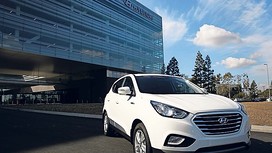October 10, 2014 – There may not be many hydrogen-fueled trucks and automobiles on British roads today but this latest announcement from the government is an encouraging sign of commitment to build out an alternate fuel infrastructure for hydrogen.
The government is funding 15 hydrogen fueling stations to be completed by the end of 2015. Toyota is beginning a trial in the United Kingdom with a hydrogen-fuel-cell-powered car. Hyundai is also bringing a hydrogen-powered vehicle (see picture of the ix35 Hyundai model below) to Britain.
Hydrogen fuel cells provide a range of 650 kilometers (about 400 miles) between fueling stops which take about the same time required to gas up today rather than the prolonged charge time requirements for pure electric vehicles (EVs).
Don’t get too excited right away. The United Kingdom currently has 10 hydrogen fuel-cell vehicles registered to private owners, a fleet of London taxis, and 8 hydrogen-powered buses.
Not every automobile manufacturer has bought in. Honda will soon join Hyundai and Toyota, but Nissan is betting on pure EVs like its Leaf model. Its reasoning – it is easier to build an EV charging infrastructure than a hydrogen one, and EVs already have a head start in the market.
The United Kingdom’s hydrogen consortium, known as UKH2Mobility, includes Daimler, Hyundai, Toyota and Nissan (although the latter from the above comments appears to be highly skeptical of hydrogen’s success). These manufacturers are gearing up for annual sales of 300,000 and 1.6 million of these vehicles on British roads by 2030. The infrastructure envisaged would include a network of 1,150 refueling stations. If deployed CO2 vehicle emissions could be reduced by 3 million tons annually.
The government’s ultimate goal is to have by 2040 only ultra-low emission vehicles on British roads.











